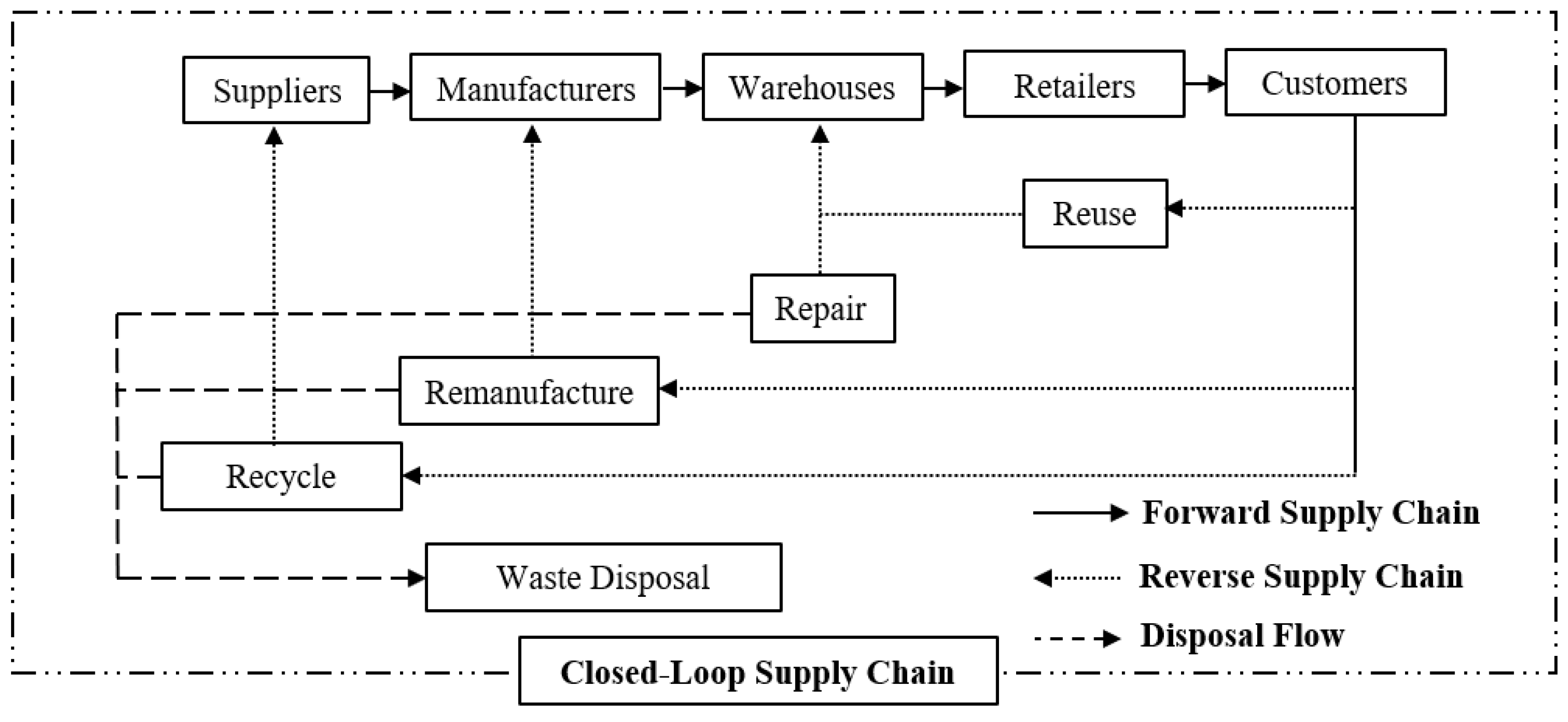Optimization Approaches for Multiple Conflicting Objectives in Sustainable Green Supply Chain Management
Abstract
1. Introduction
2. Green Supply Chain Management
2.1. Forward Supply Chain
2.2. Reverse Supply Chain
2.3. Closed-Loop Supply Chain
3. Model Formulation Techniques
3.1. Deterministic Parameters
3.2. Uncertain Parameters
4. Solution Methods for Multiobjective Optimization Problems
4.1. Classical Methods
4.1.1. Weighted Sum Method
4.1.2. ε-Constraint Method
4.1.3. Weighted Metrics Method
4.2. Evolutionary Methods
4.2.1. Genetic Algorithm (GA)
4.2.2. Non-Dominated Sorting Genetic Algorithm II (NSGA-II)
4.2.3. Multiobjective Particle Swarm Optimization (MOPSO)
4.2.4. Ant Colony Optimization (ACO)
4.3. Iterative Methods
4.3.1. Method of Geoffrion–Dyer–Feinberg (GDF)
4.3.2. Reference Point Method
5. Research Findings of MOO Techniques in Green Supply Chain
5.1. Classic Techniques
5.2. Evolutionary Methods
5.3. Iterative Methods
6. Potential Research Opportunities and Future Work
6.1. Exploring Different Multiobjective Optimization Techniques
6.2. Addressing the Uncertain Parameters
6.3. Understanding the Environmental and Social Aspects
7. Conclusions and Implications
7.1. Theoretical and Practical Implications
7.2. Conclusions
Author Contributions
Funding
Conflicts of Interest
Abbreviations
| ACO | Ant colony optimization |
| CO2 | Carbon dioxide |
| DM | Decisionmakers |
| GA | Genetic algorithm |
| GDF | Method of Geoffrion–Dyer–Feinberg |
| GSCM | Green supply chain management |
| MOACO | Multiobjective ant colony optimization |
| MOGA | Multiobjective genetic algorithm |
| MOO | Multiobjective optimization |
| MOPSO | Multiobjective particle swarm optimization |
| MOVPSO | Multiobjective vortex particle swarm optimization |
| NSGA-II | Non-dominated sorting genetic algorithm II |
| PSO | Particle swarm optimization |
| SCM | Supply chain management |
| SEAMO2 | Simple evolutionary multiobjective optimization 2 |
| SSCM | Sustainable supply chain management |
| TV-MOPSO | Time variant multiobjective particle swarm optimization |
References
- Tozanlı, Ö.; Kongar, E. Integration of industry 4.0 principles into reverse logistics operations for improved value creation: A case study of a mattress recycling company. In Enterprise & Business Management: A Handbook for Educators, Consultants, and Practitioners; Erkollar, A., Ed.; Nomos Verlagsgesellschaft mbH & Co KG: Baden-Baden, Germany, 2020; pp. 1–17. [Google Scholar]
- Christopher, M. Logistics & Supply Chain Management: Creating Value-Adding Networks (Financial Times Series); Harvard Business School Press: Boston, MA, USA, 2005. [Google Scholar]
- Shi, V.G.; Koh, S.L.; Baldwin, J.; Cucchiella, F. Natural resource based green supply chain management. Supply Chain Manag. Int. J. 2012, 17, 54–67. [Google Scholar]
- Zhang, S.; Lee, C.K.; Chan, H.K.; Choy, K.L.; Wu, Z. Swarm intelligence applied in green logistics: A literature review. Eng. Appl. Artif. Intell. 2015, 37, 154–169. [Google Scholar] [CrossRef]
- Tseng, M.-L.; Islam, M.S.; Karia, N.; Fauzi, F.A.; Afrin, S. A literature review on green supply chain management: Trends and future challenges. Resour. Conserv. Recycl. 2019, 141, 145–162. [Google Scholar] [CrossRef]
- Maditati, D.R.; Munim, Z.H.; Schramm, H.-J.; Kummer, S. A review of green supply chain management: From bibliometric analysis to a conceptual framework and future research directions. Resour. Conserv. Recycl. 2018, 139, 150–162. [Google Scholar] [CrossRef]
- Wu, H.J.; Dunn, S.C. Environmentally responsible logistics systems. Int. J. Phys. Distrib. Logist. Manag. 1995, 25, 20–38. [Google Scholar] [CrossRef]
- Fortes, J. Green supply chain management: A literature. Otago Manag. Grad. Rev. 2009, 7, 51–62. [Google Scholar]
- de Oliveira, U.R.; Espindola, L.S.; da Silva, I.R.; da Silva, I.N.; Rocha, H.M. A systematic literature review on green supply chain management: Research implications and future perspectives. J. Clean. Prod. 2018, 187, 537–561. [Google Scholar] [CrossRef]
- Yodo, N.; Dey, A. Multi-Objective Optimization for FDM Process Parameters with Evolutionary Algorithms. In Fused Deposition Modeling Based 3D Printing; Springer: Cham, Switzerland, 2021; pp. 419–444. [Google Scholar]
- Seydanlou, P.; Jolai, F.; Tavakkoli-Moghaddam, R.; Fathollahi-Fard, A.M. A multi-objective optimization framework for a sustainable closed-loop supply chain network in the olive industry: Hybrid meta-heuristic algorithms. Expert Syst. Appl. 2022, 203, 117566. [Google Scholar] [CrossRef]
- Resat, H.G.; Unsal, B. A novel multi-objective optimization approach for sustainable supply chain: A case study in packaging industry. Sustain. Prod. Consum. 2019, 20, 29–39. [Google Scholar] [CrossRef]
- Gutierrez-Franco, E.; Polo, A.; Clavijo-Buritica, N.; Rabelo, L. Multi-Objective Optimization to Support the Design of a Sustainable Supply Chain for the Generation of Biofuels from Forest Waste. Sustainability 2021, 13, 7774. [Google Scholar] [CrossRef]
- Geng, N.; Sun, Y. Multiobjective optimization of sustainable WCO for biodiesel supply chain network design. Discret. Dyn. Nat. Soc. 2021, 2021, 6640358. [Google Scholar] [CrossRef]
- Jayarathna, C.P.; Agdas, D.; Dawes, L.; Yigitcanlar, T. Multi-Objective Optimization for Sustainable Supply Chain and Logistics: A Review. Sustainability 2021, 13, 13617. [Google Scholar] [CrossRef]
- van der Plas, C.; Tervonen, T.; Dekker, I.R. Evolutionary Multi-Objective Optimization and Preference Modeling in Green Logistics. Master’s Thesis, Erasmus University Rotterdam, Rotterdam, The Netherlands, 2012. Available online: http://hdl.handle.net/2105/11492 (accessed on 13 January 2022).
- Saffar, M.; Razmi, J. A new multi objective optimization model for designing a green supply chain network under uncertainty. Int. J. Ind. Eng. Comput. 2015, 6, 15–32. [Google Scholar] [CrossRef][Green Version]
- Talaei, M.; Moghaddam, B.F.; Pishvaee, M.S.; Bozorgi-Amiri, A.; Gholamnejad, S. A robust fuzzy optimization model for carbon-efficient closed-loop supply chain network design problem: A numerical illustration in electronics industry. J. Clean. Prod. 2016, 113, 662–673. [Google Scholar] [CrossRef]
- Zhao, R.; Liu, Y.; Zhang, N.; Huang, T. An optimization model for green supply chain management by using a big data analytic approach. J. Clean. Prod. 2017, 142, 1085–1097. [Google Scholar] [CrossRef]
- Nurjanni, K.P.; Carvalho, M.S.; Costa, L. Green supply chain design: A mathematical modeling approach based on a multi-objective optimization model. Int. J. Prod. Econ. 2017, 183, 421–432. [Google Scholar] [CrossRef]
- Rad, R.S.; Nahavandi, N. A novel multi-objective optimization model for integrated problem of green closed loop supply chain network design and quantity discount. J. Clean. Prod. 2018, 196, 1549–1565. [Google Scholar]
- Midya, S.; Roy, S.K.; Yu, V.F. Intuitionistic fuzzy multi-stage multi-objective fixed-charge solid transportation problem in a green supply chain. Int. J. Mach. Learn. Cybern. 2021, 12, 699–717. [Google Scholar] [CrossRef]
- Yu, Z.; Khan, S.A.R. Green supply chain network optimization under random and fuzzy environment. Int. J. Fuzzy Syst. 2022, 24, 1170–1181. [Google Scholar] [CrossRef]
- Harris, I.; Mumford, C.; Naim, M. The multi-objective uncapacitated facility location problem for green logistics. In Proceedings of the 2009 IEEE Congress on Evolutionary Computation, Trondheim, Norway, 18–21 May 2009. [Google Scholar]
- Yeh, W.-C.; Chuang, M.-C. Using multi-objective genetic algorithm for partner selection in green supply chain problems. Expert Syst. Appl. 2011, 38, 4244–4253. [Google Scholar] [CrossRef]
- Harris, I.; Mumford, C.L.; Naim, M.M. A hybrid multi-objective approach to capacitated facility location with flexible store allocation for green logistics modeling. Transp. Res. Part E Logist. Transp. Rev. 2014, 66, 1–22. [Google Scholar] [CrossRef]
- Tang, X.; Zhang, J. The multi-objective capacitated facility location problem for green logistics. In Proceedings of the 2015 4th International Conference on Advanced Logistics and Transport (ICALT), Valenciennes, France, 20–22 May 2015. [Google Scholar]
- Soleimani, H.; Govindan, K.; Saghafi, H.; Jafari, H. Fuzzy multi-objective sustainable and green closed-loop supply chain network design. Comput. Ind. Eng. 2017, 109, 191–203. [Google Scholar] [CrossRef]
- Garg, K.; Kannan, D.; Diabat, A.; Jha, P. A multi-criteria optimization approach to manage environmental issues in closed loop supply chain network design. J. Clean. Prod. 2015, 100, 297–314. [Google Scholar] [CrossRef]
- Pishvaee, M.S.; Torabi, S.A.; Razmi, J. Credibility-based fuzzy mathematical programming model for green logistics design under uncertainty. Comput. Ind. Eng. 2012, 62, 624–632. [Google Scholar] [CrossRef]
- Wee, H.-M.; Lee, M.-C.; Yu, J.C.P.; Edward Wang, C. Optimal replenishment policy for a deteriorating green product: Life cycle costing analysis. Int. J. Prod. Econ. 2011, 133, 603–611. [Google Scholar] [CrossRef]
- Ahi, P.; Searcy, C. A comparative literature analysis of definitions for green and sustainable supply chain management. J. Clean. Prod. 2013, 52, 329–341. [Google Scholar] [CrossRef]
- Fiksel, J. Design for Environment: Creating Eco-Efficient Products and Processes; McGraw-Hill Professional Publishing: New York, NY, USA, 1996. [Google Scholar]
- Gungor, A.; Gupta, S.M. Issues in environmentally conscious manufacturing and product recovery: A survey. Comput. Ind. Eng. 1999, 36, 811–853. [Google Scholar] [CrossRef]
- Zhu, Q.; Sarkis, J. The moderating effects of institutional pressures on emergent green supply chain practices and performance. Int. J. Prod. Res. 2007, 45, 4333–4355. [Google Scholar] [CrossRef]
- Tseng, M.L.; Chiu, A.S.F. Grey-Entropy Analytical Network Process for Green Innovation Practices. Procedia-Soc. Behav. Sci. 2012, 57, 10–21. [Google Scholar] [CrossRef]
- Salimifard, K.; Shahbandarzadeh, H.; Raeesi, R. Green transportation and the role of operation research. In Proceedings of the 2012 International Conference on Traffic and Transportation Engineering (ICTTE 2012), Belgrade, Serbia, 29–30 November 2012. [Google Scholar]
- Murphy, P.R.; Poist, R.F. Green logistics strategies: An analysis of usage patterns. Transp. J. 2000, 40, 5–16. [Google Scholar]
- Hervani, A.A.; Helms, M.M.; Sarkis, J. Performance measurement for green supply chain management. Benchmarking Int. J. 2005, 12, 330–353. [Google Scholar] [CrossRef]
- Björklund, M.; Martinsen, U.; Abrahamsson, M. Performance measurements in the greening of supply chains. Supply Chain Manag. Int. J. 2012, 17, 29–39. [Google Scholar] [CrossRef]
- Judge, W.Q.; Elenkov, D. Organizational capacity for change and environmental performance: An empirical assessment of Bulgarian firms. J. Bus. Res. 2005, 58, 893–901. [Google Scholar] [CrossRef]
- Wagner, M.; Van Phu, N.; Azomahou, T.; Wehrmeyer, W. The relationship between the environmental and economic performance of firms: An empirical analysis of the European paper industry. Corp. Soc. Responsib. Environ. Manag. 2002, 9, 133–146. [Google Scholar] [CrossRef]
- Sarkis, J.; Cordeiro, J.J. An empirical evaluation of environmental efficiencies and firm performance: Pollution prevention versus end-of-pipe practice. Eur. J. Oper. Res. 2001, 135, 102–113. [Google Scholar] [CrossRef]
- Vachon, S.; Klassen, R.D. Extending green practices across the supply chain: The impact of upstream and downstream integration. Int. J. Oper. Prod. Manag. 2006, 26, 795–821. [Google Scholar] [CrossRef]
- Chopra, S.; Meindl, P. Strategy, planning, and operation. Supply Chain Manag. 2001, 13–17. [Google Scholar]
- Islam, M.S.; Moeinzadeh, S.; Tseng, M.-L.; Tan, K. A literature review on environmental concerns in logistics: Trends and future challenges. Int. J. Logist. Res. Appl. 2021, 24, 126–151. [Google Scholar] [CrossRef]
- Seuring, S. A review of modeling approaches for sustainable supply chain management. Decis. Support Syst. 2013, 54, 1513–1520. [Google Scholar] [CrossRef]
- Ghadimi, P.; Wang, C.; Lim, M.K. Sustainable supply chain modeling and analysis: Past debate, present problems and future challenges. Resour. Conserv. Recycl. 2019, 140, 72–84. [Google Scholar] [CrossRef]
- Khor, K.S.; Udin, Z.M. Impact of reverse logistics product disposition towards business performance in Malaysian E&E companies. J. Supply Chain Cust. Relatsh. Manag. 2012, 2012, 1. [Google Scholar]
- Govindan, K.; Paam, P.; Abtahi, A.-R. A fuzzy multi-objective optimization model for sustainable reverse logistics network design. Ecol. Indic. 2016, 67, 753–768. [Google Scholar] [CrossRef]
- Zarbakhshnia, N.; Soleimani, H.; Ghaderi, H. Sustainable third-party reverse logistics provider evaluation and selection using fuzzy SWARA and developed fuzzy COPRAS in the presence of risk criteria. Appl. Soft Comput. 2018, 65, 307–319. [Google Scholar] [CrossRef]
- Govindan, K.; Soleimani, H.; Kannan, D. Reverse logistics and closed-loop supply chain: A comprehensive review to explore the future. Eur. J. Oper. Res. 2015, 240, 603–626. [Google Scholar] [CrossRef]
- Rogers, D.S.; Tibben-Lembke, R.S. Going Backwards: Reverse Logistics Trends and Practices; Reverse Logistics Executive Council: Pittsburgh, PA, USA, 1999; Volume 2. [Google Scholar]
- Sadjadi, S.J.; Soltani, R.; Eskandarpour, A. Location based treatment activities for end of life products network design under uncertainty by a robust multi-objective memetic-based heuristic approach. Appl. Soft Comput. 2014, 23, 215–226. [Google Scholar] [CrossRef]
- Linton, J.D.; Klassen, R.; Jayaraman, V. Sustainable supply chains: An introduction. J. Oper. Manag. 2007, 25, 1075–1082. [Google Scholar] [CrossRef]
- Rubio, S.; Chamorro, A.; Miranda, F.J. Characteristics of the research on reverse logistics (1995–2005). Int. J. Prod. Res. 2008, 46, 1099–1120. [Google Scholar] [CrossRef]
- Pokharel, S.; Mutha, A. Perspectives in reverse logistics: A review. Resour. Conserv. Recycl. 2009, 53, 175–182. [Google Scholar] [CrossRef]
- Guide, V.D.R.; Van Wassenhove, L.N. The Evolution of Closed-Loop Supply Chain Research. Oper. Res. 2009, 57, 10–18. [Google Scholar] [CrossRef]
- Kumar, D.T.; Soleimani, H.; Kannan, G. Forecasting return products in an integrated forward/reverse supply chain utilizing an ANFIS. Int. J. Appl. Math. Comput. Sci. 2014, 24, 669–682. [Google Scholar] [CrossRef]
- Schenkel, M.; Caniëls, M.C.J.; Krikke, H.; van der Laan, E. Understanding value creation in closed loop supply chains—Past findings and future directions. J. Manuf. Syst. 2015, 37, 729–745. [Google Scholar] [CrossRef]
- Kumar, S.; Putnam, V. Cradle to cradle: Reverse logistics strategies and opportunities across three industry sectors. Int. J. Prod. Econ. 2008, 115, 305–315. [Google Scholar] [CrossRef]
- Lee, C.K.M.; Lam, J.S.L. Managing reverse logistics to enhance sustainability of industrial marketing. Ind. Mark. Manag. 2012, 41, 589–598. [Google Scholar] [CrossRef]
- Toffel, M. The Growing Strategic Importance of End-of-Life Product Management. Calif. Manag. Rev. 2003, 45, 102–129. [Google Scholar] [CrossRef]
- Lundmark, P.; Sundin, E.; Björkman, M. Industrial challenges within the remanufacturing system. In Proceedings of the 3rd Swedish Production Symposium 2009, Göteborg, Sweden, 2–3 December 2009. [Google Scholar]
- Asif, F.; Bianchi, C.; Rashid, A.; Nicolescu, C.M. Performance analysis of the closed loop supply chain. J. Remanufacturing 2012, 2, 1–21. [Google Scholar] [CrossRef]
- Wang, Y.-J. Ranking triangle and trapezoidal fuzzy numbers based on the relative preference relation. Appl. Math. Model. 2015, 39, 586–599. [Google Scholar] [CrossRef]
- Pathinathan, T.; Ponnivalavan, K. Reverse order triangular, trapezoidal and pentagonal fuzzy numbers. Ann. Pure Appl. Math. 2015, 9, 107–117. [Google Scholar]
- Zadeh, L. Optimality and non-scalar-valued performance criteria. IEEE Trans. Autom. Control 1963, 8, 59–60. [Google Scholar] [CrossRef]
- Gass, S.; Saaty, T. The computational algorithm for the parametric objective function. Nav. Res. Logist. Q. 1955, 2, 39–45. [Google Scholar] [CrossRef]
- Miettinen, K.; Ruiz, F.; Wierzbicki, A.P. Introduction to multiobjective optimization: Interactive approaches. In Multiobjective Optimization; Springer: Berlin/Heidelberg, Germany, 2008; pp. 27–57. [Google Scholar]
- Haimes, Y. On a bicriterion formulation of the problems of integrated system identification and system optimization. IEEE Trans. Syst. Man Cybern. 1971, 1, 296–297. [Google Scholar]
- Chankong, V.; Haimes, Y.Y. Multiobjective Decision Making: Theory and Methodology; North-Holland: New York, NY, USA, 1983. [Google Scholar]
- Mavrotas, G. Generation of Efficient Solutions in Multiobjective Mathematical Programming Problems Using GAMS. Effective Implementation of the ε-Constraint Method; Laboratory of Industrial and Energy Economics, School of Chemical Engineering, National Technical University of Athens: Zografou, Greece, 2007. [Google Scholar]
- Duckstein, L. Multiobjective Optimization in Structural Design: The Model Choice Problem; Arizona Univ Tucson Dept of Systems and Industrial Engineering: Tucson, AZ, USA, 1981. [Google Scholar]
- Zeleny, M. Compromise programming. In Multiple Criteria Decision Making; University of South Carolina Press: Columbia, SC, USA, 1973. [Google Scholar]
- Goldberg, D.E. Genetic Algorithms in Search, Optimization, and Machine Learning; Addison-Wesley Professional: Boston, MA, USA, 1989. [Google Scholar]
- Al Turki, F.A.; Al Shammari, M.M. Predicting the Output Power of a Photovoltaic Module Using an Optimized Offline Cascade-Forward Neural Network-Based on Genetic Algorithm Model. Technol. Econ. Smart Grids Sustain. Energy 2021, 6, 1–12. [Google Scholar] [CrossRef]
- Katoch, S.; Chauhan, S.S.; Kumar, V. A review on genetic algorithm: Past, present, and future. Multimed. Tools Appl. 2021, 80, 8091–8126. [Google Scholar] [CrossRef] [PubMed]
- Deb, K.; Pratap, A.; Agarwal, S.; Meyarivan, T. A fast and elitist multiobjective genetic algorithm: NSGA-II. IEEE Trans. Evol. Comput. 2002, 6, 182–197. [Google Scholar] [CrossRef]
- Srinivas, N.; Deb, K.; Roy, P.; Mehta, S. Comparative study of vector evaluated GA and NSGA applied to multiobjective optimization. In Proceedings of the Symposium on Genetic Algorithms, Dehradun, India, 25 March 1995. [Google Scholar]
- Seshadri, A. A Fast Elitist Multiobjective Genetic Algorithm: NSGA-II; MATLAB Central. 2006, Volume 182. Available online: https://web.njit.edu/~horacio/Math451H/download/Seshadri_NSGA-II.pdf (accessed on 13 January 2022).
- Yusoff, Y.; Ngadiman, M.S.; Zain, A.M. Overview of NSGA-II for optimizing machining process parameters. Procedia Eng. 2011, 15, 3978–3983. [Google Scholar] [CrossRef]
- Liu, D.; Tan, K.C.; Goh, C.K.; Ho, W.K. A Multiobjective Memetic Algorithm Based on Particle Swarm Optimization. IEEE Trans. Syst. Man Cybern. Part B (Cybern.) 2007, 37, 42–50. [Google Scholar] [CrossRef] [PubMed]
- Liu, D.S.; Tan, K.C.; Huang, S.Y.; Goh, C.K.; Ho, W.K. On solving multiobjective bin packing problems using evolutionary particle swarm optimization. Eur. J. Oper. Res. 2008, 190, 357–382. [Google Scholar] [CrossRef]
- Kennedy, J.; Eberhart, R. Particle swarm optimization. In Proceedings of the ICNN’95—International Conference on Neural Networks, Perth, WA, Australia, 27 November–1 December 1995. [Google Scholar]
- Coello, C.A.C.; Pulido, G.T.; Lechuga, M.S. Handling multiple objectives with particle swarm optimization. IEEE Trans. Evol. Comput. 2004, 8, 256–279. [Google Scholar] [CrossRef]
- Tripathi, P.K.; Bandyopadhyay, S.; Pal, S.K. Multi-Objective Particle Swarm Optimization with time variant inertia and acceleration coefficients. Inf. Sci. 2007, 177, 5033–5049. [Google Scholar] [CrossRef]
- Goh, C.K.; Tan, K.C.; Liu, D.S.; Chiam, S.C. A competitive and cooperative co-evolutionary approach to multi-objective particle swarm optimization algorithm design. Eur. J. Oper. Res. 2010, 202, 42–54. [Google Scholar] [CrossRef]
- Meza, J.; Espitia, H.; Montenegro, C.; Giménez, E.; González-Crespo, R. MOVPSO: Vortex Multi-Objective Particle Swarm Optimization. Appl. Soft Comput. 2017, 52, 1042–1057. [Google Scholar] [CrossRef]
- Dorigo, M.; Birattari, M.; Stutzle, T. Ant colony optimization. IEEE Comput. Intell. Mag. 2006, 1, 28–39. [Google Scholar] [CrossRef]
- Baykasoglu, A.; Dereli, T.; Sabuncu, I. A multiple objective ant colony optimization approach to assembly line balancing problems. In Proceedings of the 35th International Conference on Computers and Industrial Engineering (CIE35), Istanbul, Turkey, 19–22 June 2005. [Google Scholar]
- Gravel, M.; Price, W.L.; Gagné, C. Scheduling continuous casting of aluminum using a multiple objective ant colony optimization metaheuristic. Eur. J. Oper. Res. 2002, 143, 218–229. [Google Scholar] [CrossRef]
- T’Kindt, V.; Monmarché, N.; Tercinet, F.; Laügt, D. An Ant Colony Optimization algorithm to solve a 2-machine bicriteria flowshop scheduling problem. Eur. J. Oper. Res. 2002, 142, 250–257. [Google Scholar] [CrossRef]
- Barán, B.; Schaerer, M. A Multiobjective Ant Colony System for Vehicle Routing Problem with Time Windows. In Proceedings of the 21st IASTED International Multi-Conference on Applied Informatics (AI 2003), Innsbruck, Austria, 10–13 February 2003. [Google Scholar]
- Gambardella, L.M.; Taillard, É.; Agazzi, G. Macs-vrptw: A multiple colony system for vehicle routing problems with time windows. In New Ideas in Optimization; McGraw-Hill: New York, NY, USA, 1999. [Google Scholar]
- Doerner, K.; Gutjahr, W.J.; Hartl, R.F.; Strauss, C.; Stummer, C. Pareto ant colony optimization: A metaheuristic approach to multiobjective portfolio selection. Ann. Oper. Res. 2004, 131, 79–99. [Google Scholar] [CrossRef]
- García-Martínez, C.; Cordón, O.; Herrera, F. A taxonomy and an empirical analysis of multiple objective ant colony optimization algorithms for the bi-criteria TSP. Eur. J. Oper. Res. 2007, 180, 116–148. [Google Scholar] [CrossRef]
- McMullen, P.R. An ant colony optimization approach to addressing a JIT sequencing problem with multiple objectives. Artif. Intell. Eng. 2001, 15, 309–317. [Google Scholar] [CrossRef]
- Geoffrion, A.M.; Dyer, J.S.; Feinberg, A. An interactive approach for multi-criterion optimization, with an application to the operation of an academic department. Manag. Sci. 1972, 19, 357–368. [Google Scholar] [CrossRef]
- Frank, M.; Wolfe, P. An algorithm for quadratic programming. Nav. Res. Logist. Q. 1956, 3, 95–110. [Google Scholar] [CrossRef]
- López Jaimes, A.; Zapotecas-Martínez, S.; Coello, C. An Introduction to Multiobjective Optimization Techniques. In Optimization in Polymer Processing; Nova Science Publishers: Hauppauge, NY, USA, 2011; pp. 29–57. [Google Scholar]
- Miettinen, K. Interactive Methods. In Nonlinear Multiobjective Optimization; Springer: Boston, MA, USA, 1998; pp. 131–213. [Google Scholar] [CrossRef]
- Wierzbicki, A.P. The use of reference objectives in multiobjective optimization. In Multiple Criteria Decision Making Theory and Application; Springer: Berlin/Heidelberg, Germany, 1980; pp. 468–486. [Google Scholar]
- Wierzbicki, A.P. A methodological guide to multiobjective optimization. In Optimization Techniques; Springer: Berlin/Heidelberg, Germany, 1980; pp. 99–123. [Google Scholar]
- Miettinen, K. Introduction to multiobjective optimization: Noninteractive approaches. In Multiobjective Optimization; Springer: Berlin/Heidelberg, Germany, 2008; pp. 1–26. [Google Scholar]
- Dujardin, Y.; Chades, I. Solving multi-objective optimization problems in conservation with the reference point method. PLoS ONE 2018, 13, e0190748. [Google Scholar] [CrossRef] [PubMed]
- Tavana, M.; Tohidi, H.; Alimohammadi, M.; Lesansalmasi, R. A location-inventory-routing model for green supply chains with low-carbon emissions under uncertainty. Environ. Sci. Pollut. Res. 2021, 28, 50636–50648. [Google Scholar] [CrossRef] [PubMed]
- Cui, Y.; Geng, Z.; Zhu, Q.; Han, Y. Review: Multi-objective optimization methods and application in energy saving. Energy 2017, 125, 681–704. [Google Scholar] [CrossRef]
- Yodo, N.; Wang, P. Resilience modeling and quantification for engineered systems using Bayesian networks. J. Mech. Des. 2016, 138, 031404. [Google Scholar] [CrossRef]
- Gopalakrishnan, K.; Yusuf, Y.Y.; Musa, A.; Abubakar, T.; Ambursa, H.M. Sustainable supply chain management: A case study of British Aerospace (BAe) Systems. Int. J. Prod. Econ. 2012, 140, 193–203. [Google Scholar] [CrossRef]
- Afrin, T.; Yodo, N. A survey of road traffic congestion measures towards a sustainable and resilient transportation system. Sustainability 2020, 12, 4660. [Google Scholar] [CrossRef]
- Beamon, B.M. Designing the green supply chain. Logist. Inf. Manag. 1999, 12, 332–342. [Google Scholar] [CrossRef]
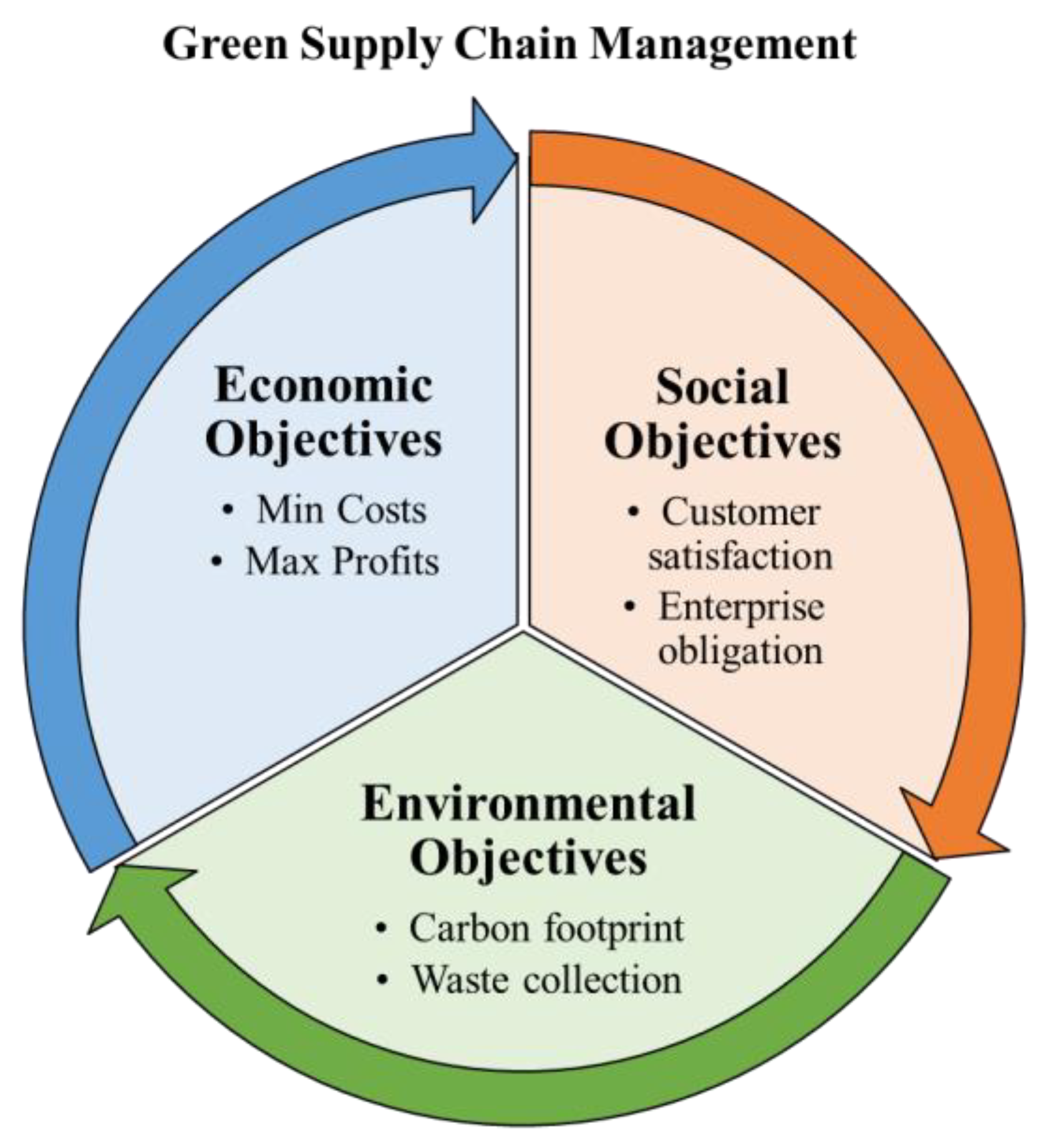
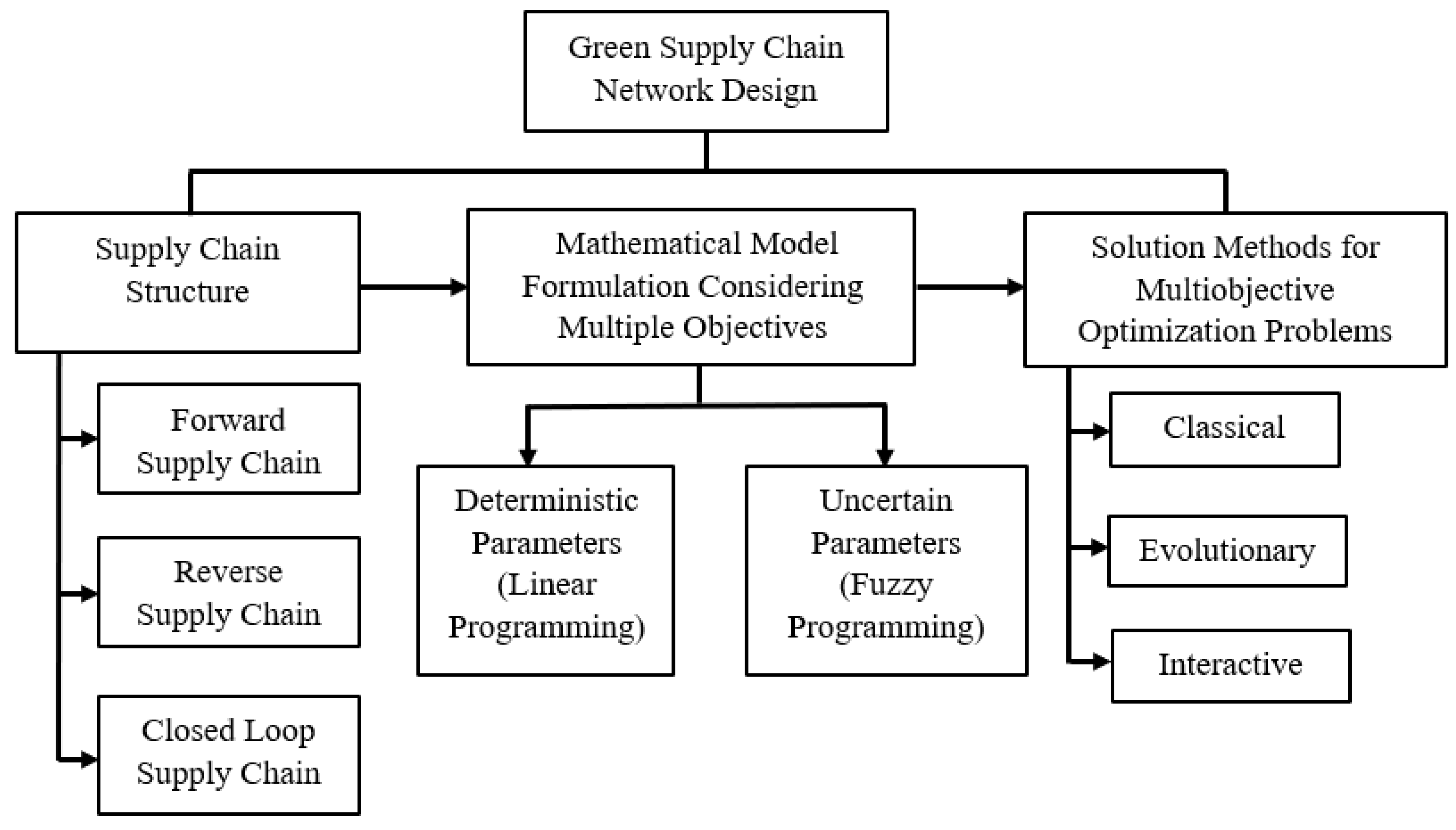

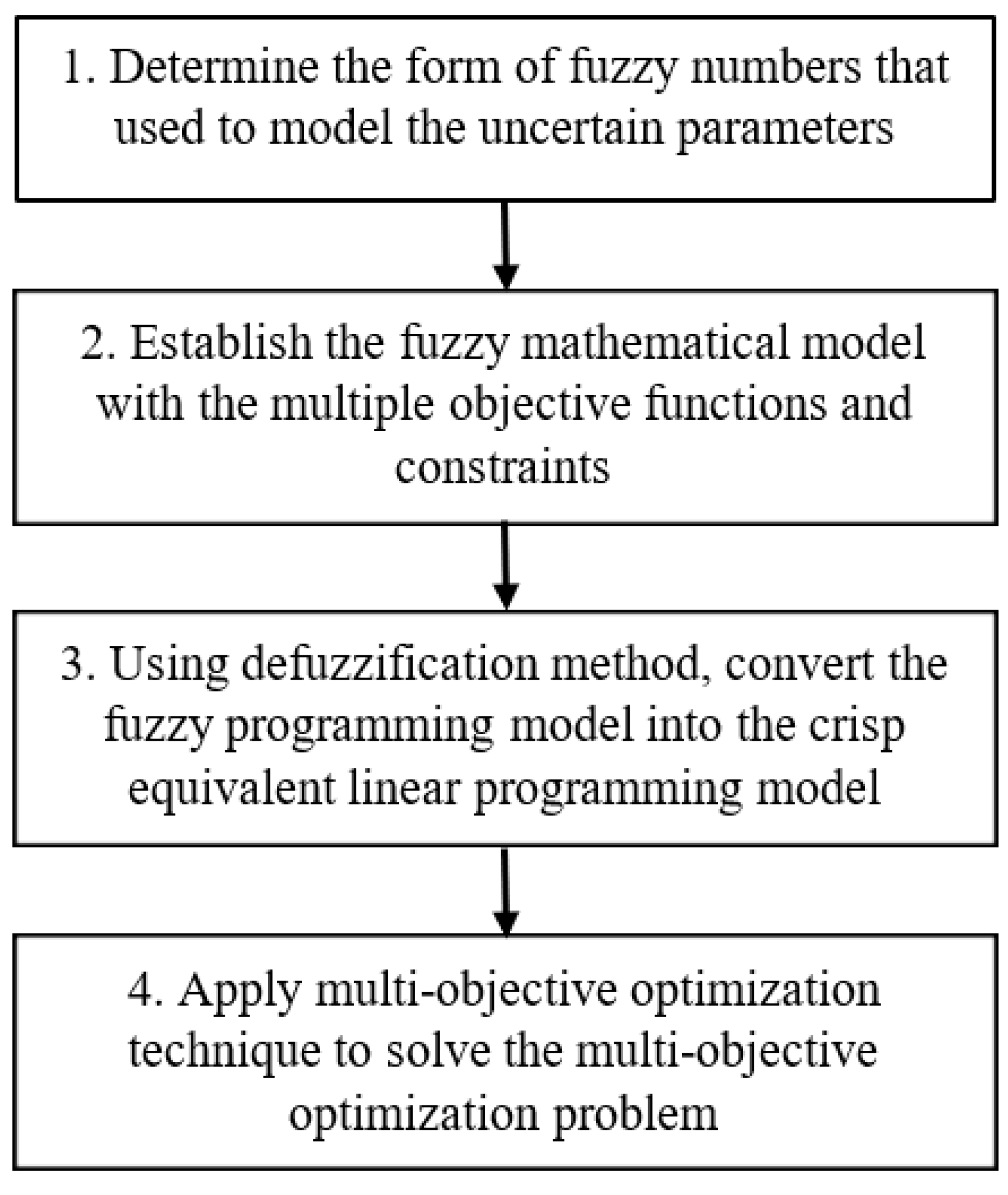
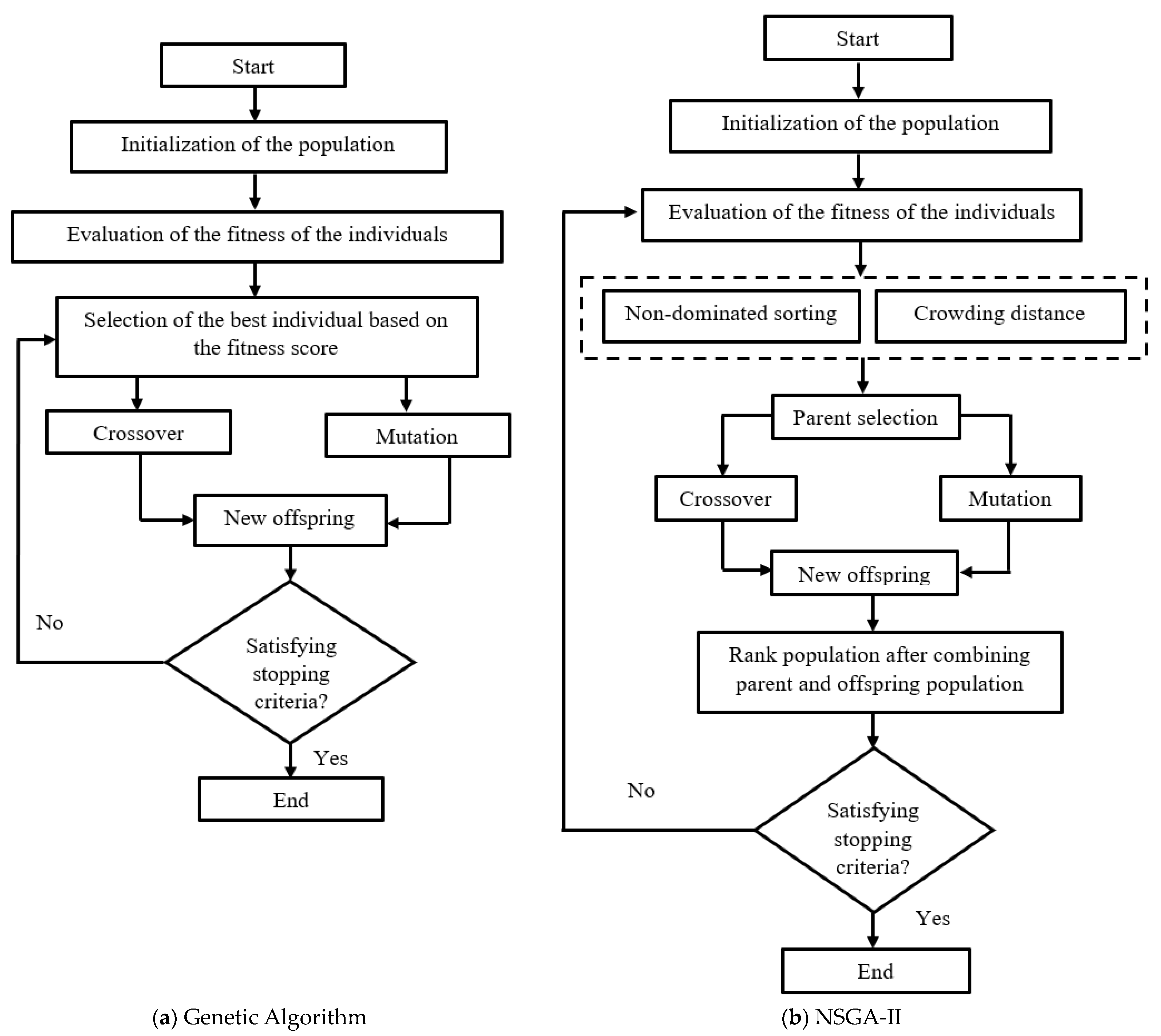
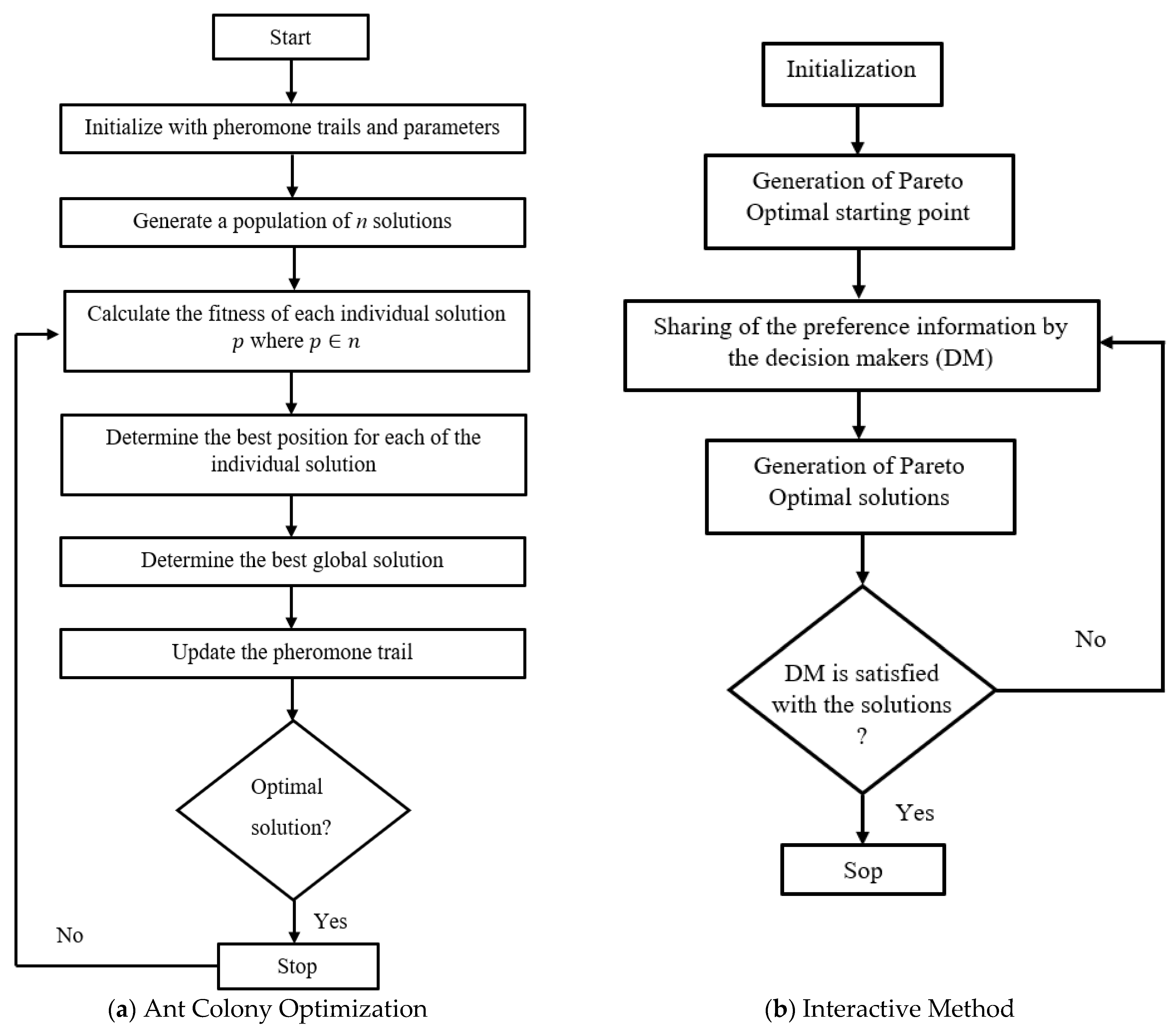
| References | Fuzzy Number | Uncertain Parameters |
|---|---|---|
| Pishvaee et al., 2012 [30] | Trapezoidal fuzzy number | Demands of the customers, capacities, fixed opening costs, transportation costs, production costs, and carbon dioxide CO2 emission factors |
| Saffar et al., 2015 [17] | Data triangular fuzzy number | Fixed cost, production cost, maintenance cost, transportation cost, CO2 emission rate in different activity levels, return and recovery rates |
| Talaei et al., 2016 [18] | Trapezoidal fuzzy number | Variable costs and demands |
| Midya et al., 2021 [22] | Trapezoidal fuzzy number | Fixed and transportation cost, transportation time, carbon emission quantity, capacity, and demand |
| Yu and Khan, 2022 [23] | Triangular fuzzy number | Costs (transportation, distribution, processing, shortage), space occupied by processing products, carbon emissions during processing products and demand |
| References | Optimization Objectives | Solving Techniques | Supply Chain Network |
|---|---|---|---|
| Van der Plas et al., 2012 [16] | Minimization of total cost and total emission | Weighted sum method, ε-constraint method | Reverse supply chain network design |
| Saffar et al., 2015 [17] | Minimization of cost and CO2 emission | ε-constraint method | Closed-loop supply chain network design |
| Talaei et al., 2016 [18] | Minimization of cost and CO2 emission | ε-constraint method | Closed-loop supply chain network design |
| Zhao et al., 2017 [19] | Minimization of risk, CO2 emission, and cost | ε-constraint method and ideal point method | Forward supply chain network design |
| Nurjanni et al., 2017 [20] | Minimization of cost and CO2 emission | Weighted sum method | Closed-loop supply chain network design |
| Rad and Nahavandi, 2018 [21] | Minimization of cost and CO2 emission | -metrics method | Closed-loop supply chain network design using quantity discount |
| Midya et al., 2021 [22] | Minimization of the transportation cost, time, and CO2 emission | Weighted Tchebycheff Min–max goal programming | Forward supply chain network design |
| Franco et al., 2021 [13] | Maximization of the overall profit, employment generation, and minimizing carbon emission | ε-constraint method | Sustainable supply chain network for biofuel generation from the forest waste |
| Yu and Khan, 2022 [23] | Minimization of the total cost, variance model of the cost, risk function, and carbon emission | Integrated hierarchical method with ε-constraint method and weighted ideal point method | Forward supply chain network design |
| References | Optimization Objectives | Solving Techniques | Supply Chain Network |
|---|---|---|---|
| Harris et al., 2009 [24] | Minimization of cost uncovered demand, and environmental impact from transport and depots | NSGA-II | Incapacitated facility location problem in logistics network design |
| Yeh and Chuang, 2011 [25] | Minimization of cost and time, maximization of average product quality, green appraisal score | GA | Green supplier selection |
| Van der Plas et al., 2012 [16] | Minimization of total cost and total emission | NSGA-II | Reverse supply chain network design |
| Harris et al., 2014 [26] | Minimization of cost and CO2 emission from transport and depots | SEAMO2 | Capacitated facility location-allocation problem |
| Tang and Zhang, 2015 [27] | Minimization of economic cost and CO2 emission, maximization of minimal service reliability | Hybrid Evolutionary | Capacitated facility location problem in logistics network design |
| Soleimani et al., 2017 [28] | Maximization of the chain profit and the customer demand, minimization of the number of missed working days due to occupational accidents | GA | Closed-loop supply chain network design |
| Geng ang Sun, 2021 [14] | Minimization of total cost, carbon emission, and unused kitchen waste | NSGA-II | Biodiesel supply chain network design |
| References | Optimization Objectives | Solving Techniques | Supply Chain Network |
|---|---|---|---|
| Pishvaee et al., 2012 [30] | Minimize cost and CO2 emission | Fuzzy interactive solution method | Forward supply chain network design |
| Garg et al., 2015 [29] | Maximize the total profit and CO2 emissions by reducing transporting vehicles in the forward supply chain | Interactive multiobjective optimization | Closed-loop supply chain network design |
Publisher’s Note: MDPI stays neutral with regard to jurisdictional claims in published maps and institutional affiliations. |
© 2022 by the authors. Licensee MDPI, Basel, Switzerland. This article is an open access article distributed under the terms and conditions of the Creative Commons Attribution (CC BY) license (https://creativecommons.org/licenses/by/4.0/).
Share and Cite
Asha, L.N.; Dey, A.; Yodo, N.; Aragon, L.G. Optimization Approaches for Multiple Conflicting Objectives in Sustainable Green Supply Chain Management. Sustainability 2022, 14, 12790. https://doi.org/10.3390/su141912790
Asha LN, Dey A, Yodo N, Aragon LG. Optimization Approaches for Multiple Conflicting Objectives in Sustainable Green Supply Chain Management. Sustainability. 2022; 14(19):12790. https://doi.org/10.3390/su141912790
Chicago/Turabian StyleAsha, Labiba Noshin, Arup Dey, Nita Yodo, and Lucy G. Aragon. 2022. "Optimization Approaches for Multiple Conflicting Objectives in Sustainable Green Supply Chain Management" Sustainability 14, no. 19: 12790. https://doi.org/10.3390/su141912790
APA StyleAsha, L. N., Dey, A., Yodo, N., & Aragon, L. G. (2022). Optimization Approaches for Multiple Conflicting Objectives in Sustainable Green Supply Chain Management. Sustainability, 14(19), 12790. https://doi.org/10.3390/su141912790





